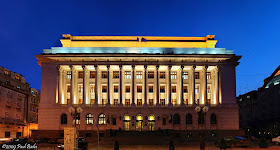
The National Bank of Romania (Romanian: Banca Naţională a României, BNR) is the central bank of Romania and was established in April 1880. It is located in the capital city, Bucharest. The bank's first governor was Eugeniu Carada; the present governor is Mugur Isărescu.
History
In 1916, in the wake of the Central Powers' invasion, the valuables of the National Bank of Romania, together with many other valuables (the Romanian Treasure) were sent to Moscow for safekeeping, but were never returned (except for the Pietroasele treasure - now on display at the National Museum of Romanian History, the numismatic collection of the National Bank, some paintings and archives).
On July 28, 1959, an armed group of six members of the Romanian Communist Party apparatus (the Ioanid Gang: Alexandru Ioanid, Paul Ioanid, Igor Sevianu, Monica Sevianu, Saşa Muşat and Haralambie Obedeanu) stole from an armored car of the National Bank of Romania 1,600,000 lei (about 250,000 U.S. dollars at 1959 prices). It was probably the most scandalous bank robbery in the Eastern bloc.
The Old NBR Palace
The head office of the National Bank of Romania with the view of Lipscani Street is one of the most imposing and massive bank edifices in Romania, nowadays a historic, art monument, and protected as such. It was erected on the former site of the inn built by Şerban Cantacuzino (1678-1688).
On 26 February 1882, architects Cassien Bernard and Albert Galleron were assigned the task to blueprint the NBR Palace. The construction of the building in the eclectic style of the late 19th century, with some neo-classical elements, proceeded between 12 July 1884 (when the foundation stone was laid) and June 1890 under the direction of the architect engineer Nicolae Cerchez assisted by architect E. Băicoianu.
The New NBR Palace
With the façade on Doamnei Street, the new wing of the NBR Palace was built during World War II, after having laid the foundation stone back in 1937.
The construction works carried on between 1942-44 under the direction of architect Ion Davidescu assisted by two other architects, Radu Dudescu and N. Creţoiu.
The building is emblematic of the neo-classical style with rationalist influences that prevailed in the interwar period. It impresses by the monumental granite stairs, the huge Corinthian columns forming the façade, and the large, white marble-coated halls inside the building.
No comments:
Post a Comment